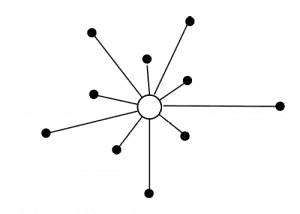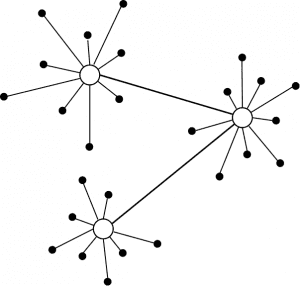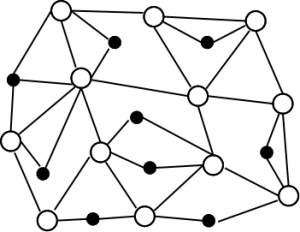
Though every business network is unique, they all broadly fall under one of the following architecture categories: centralized (or decentralized using server clusters) and distributed. Let’s discuss how centralized vs. distributed network management models work, comparing the advantages and disadvantages of each. By the end of this article, you will better understand each of these architectures to decide which is the right approach for managing your enterprise IT assets.
Centralized network management
 A centralized network is built around a single, central server that handles all major management and data processing functions. Other types of servers may connect to this master server and manage other specific functions, but those other servers cannot work independently of the central server.
A centralized network is built around a single, central server that handles all major management and data processing functions. Other types of servers may connect to this master server and manage other specific functions, but those other servers cannot work independently of the central server.
Client systems and users cannot directly access resources or services on different servers without first going through the centralized master server. If the central server goes down, the entire network goes down with it. An example of a centralized network would be a small business using a single domain controller (DC). They might have a separate database server or print server, but that server relies on the DC for clock synchronization, identity management and authentication, DHCP, and other vital network services.
Let’s take a look at the advantages and disadvantages of centralized network management:
| Centralized Network Management |
| Advantages | Disadvantages |
| A single central server is quick and easy to deploy because you only have to manage one configuration without load balancing or orchestration. | A single master server presents a single point of failure on the network. If the master server goes down because of a bug or attack, or if you need to restart the server for maintenance, your entire network goes down. |
| You can easily add and remove client systems, users, and other servers without waiting for replication among decentralized or distributed servers. | All your valuable and sensitive data is stored and accessible from one server in a centralized network, presenting a security risk. If hackers get into your single DC, they can access everything from that one location, rather than needing to jump to different systems and servers to find everything they want. |
| Centralized networks are relatively inexpensive because you’re using a limited number of servers, which means purchasing less equipment and fewer licenses. | Centralized networks are challenging to scale because there’s a limit to how much computing power you can add to a single server. A central server can also create bottlenecks when your network traffic increases beyond the limitations of a single node. |
Because this model simply cannot cope with the amount of network traffic and computing power needed in an enterprise environment, proper centralized network management isn’t used much anymore, outside of small businesses and specialized LANs. Older network management guides list Wikipedia as an example of a centralized network. In the early days of the internet, Wikipedia’s database would have been stored on one central server. Every time you wanted to read an article, your computer would need to communicate with that central server across the internet. Now, of course, a single server couldn’t possibly handle all of Wikipedia’s data and traffic.
Many companies have turned their centralized network into a decentralized network by implementing server clusters to handle vital network processes, so understanding decentralized network management is important when deciding which network management model to use.
Decentralized network management

Decentralized network management does not evenly or automatically split network loads among the cluster of master servers but instead splits the load according to parameters specified by the network admin. An example of a decentralized network would be a small or medium business (SMB) that uses three domain controllers. Each DC provides the same crucial network services, but the business has split their client systems and users between the three DCs, so each one only handles roughly 1/3 of the total load. If one DC goes down, its load gets temporarily redirected to another DC until the issue is fixed.
Let’s explore the main advantages and disadvantages of this model:
| Decentralized Network Management |
| Advantages | Disadvantages |
| Decentralized networks are more reliable than centralized networks because there are multiple points of failure. | Decentralized networks are more expensive and time-consuming to deploy because you need to install and configure multiple servers with load balancing and failover capabilities. |
| Decentralized network management scales more efficiently since it enables you to add more servers to the cluster as your business grows. | Decentralized networks require replication and coordination among multiple servers, and any errors or interruptions in this process can cause security issues and service disruptions. |
| There are fewer bottlenecks in a decentralized network because this model can split traffic among multiple servers, and those servers can also be deployed to branch offices and data centers. | Though a decentralized network is more secure than a centralized network because there are more points of failure, the replication between master servers ensures that hackers can still access most or all your network from a single location. |
The main difference between a centralized and decentralized network is the number of master servers that control and coordinate your network services and processes. A centralized network relies on a single central server or domain controller, which simplifies your network management but presents many limitations. A decentralized network is controlled by a cluster of domain controllers that share the network load and provide redundancy if one server goes down.
Decentralized networks are by far the most common type because they address many of the limitations of a centralized network. However, there’s another network architecture that takes things a step further.
Distributed network management

A distributed network doesn’t use a single central server or a cluster of domain controllers—all data processing, computational resources, and network management functions are shared by nodes distributed geographically and logically across the whole enterprise network.
Some distributed networks go even further by crowdsourcing processing power from client systems (desktop and laptop computers), taking advantage of how overpowered and underutilized a lot of these devices can be.
An example of a distributed network would be a large enterprise with thousands of employees and systems that are geographically spread out across branch offices and data centers. Rather than putting a single DC (or DC cluster) in each remote location, they’ve distributed servers throughout the network and use network orchestration to balance the load automatically and continuously among them. Let’s explore the advantages and disadvantages of distributed network management:
| Distributed Network Management |
| Advantages | Disadvantages |
| Distributed networks are extremely fault-tolerant because any server can fail independently without impacting the rest of the network at all—that server’s functions are automatically shared among the other available servers. | Distributed network management is more expensive because it requires network orchestration tools to provide continuous load balancing and ensure that all nodes coordinate with each other for configuration and routing updates and changes to security policies. |
| Distributed networks are highly scalable because you can add new servers wherever they’re needed at any time. | Distributed networks are more complicated to architect and implement, and not as many network engineers and sysadmins have hands-on experience working with them. |
| Distributed networks experience lower latency than other architectures because network processing power is evenly distributed among many nodes. | |
| On a distributed network, no single server controls all your enterprise’s sensitive data and critical services. If a hacker breaches one node, they’ll only be able to see the process and resources controlled by that individual server. | |
| A hacker can only inflict minimal damage to a server on a distributed network before your network orchestration solution redistributes network processes to a different server. |
Distributed network management advantages greatly outweigh its disadvantages and take decentralization to a new level by equally and automatically sharing processes, tasks, and functions among servers across your entire enterprise network. Though distributed networks are not yet as common as centralized or decentralized networks, they benefit large business networks and may see greater future adoption.
Choosing between centralized vs. distributed network management
Comparing centralized vs. distributed network management is a moot point for most organizations because centralized architectures are too limited for the needs of the modern enterprise network and have fallen out of favor. In some circumstances, you may still find centralized network management helpful, such as data center management and isolated LANs used for testing environments or government classified work.
However, most organizations use a decentralized network architecture that relies on clusters of master servers to coordinate and control network processes and functions. Decentralized network management can be deployed across multiple data centers, colocation sites, and branch offices. Making them ideal for enterprises who need fast and reliable access to network resources, but don’t have the expertise or tools to implement a fully distributed network.
Distributed network management further decentralizes your network by moving your master servers out among the other systems on your network. Distributed networks are fault-tolerant, highly scalable, and are generally faster and more secure than different network architectures. However, distributed networks are more complicated to orchestrate and manage, which can be a barrier to adoption. Distributed network management can be used in the same scenarios as decentralized networks but is typically favored by high-tech organizations that prioritize security and privacy. For example, cryptocurrencies tend to use distributed networks, so it’s nearly impossible for a hacker to access the entire database of digital wallets or take down the network.
No matter which network architecture you choose, ZPE Systems’ Nodegrid can help you simplify your infrastructure management. Nodegrid brings all your infrastructure under one centralized management interface, overcoming the challenges of distributed network management.
Still can’t choose between centralized vs. distributed network management?
Contact ZPE Systems to discover how our Nodegrid solutions can help simplify your distributed network management and orchestration.
